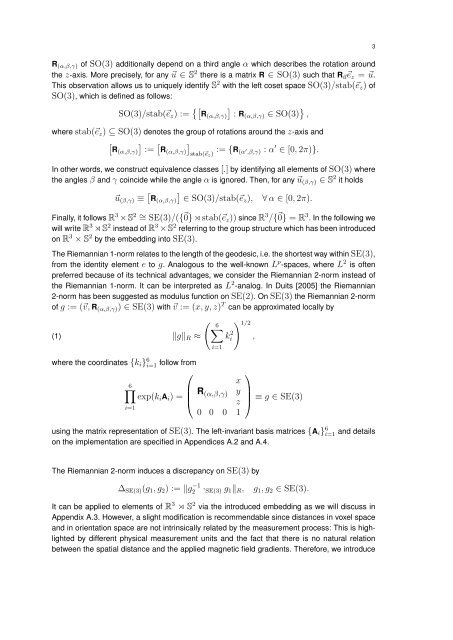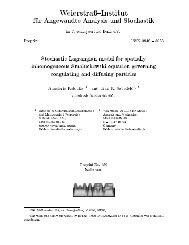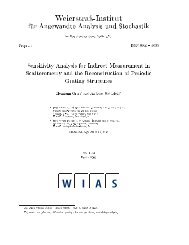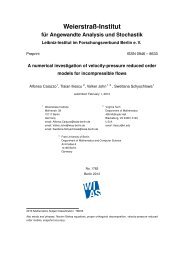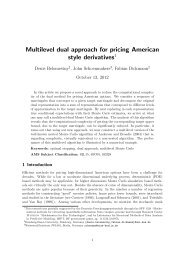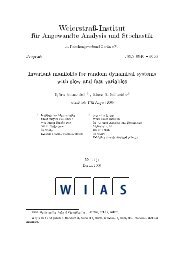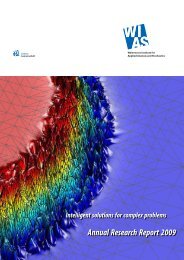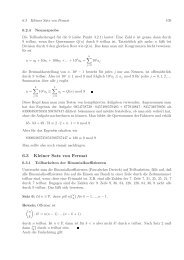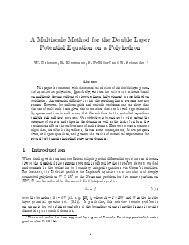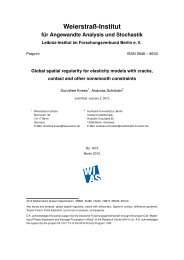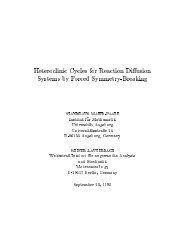PDF (5143 kByte) - WIAS
PDF (5143 kByte) - WIAS
PDF (5143 kByte) - WIAS
Create successful ePaper yourself
Turn your PDF publications into a flip-book with our unique Google optimized e-Paper software.
R(α,β,γ) of SO(3) additionally depend on a third angle α which describes the rotation around<br />
the z-axis. More precisely, for any u ∈ S2 there is a matrix R ∈ SO(3) such that Ruez = u.<br />
This observation allows us to uniquely identify S2 with the left coset space SO(3)/stab(ez) of<br />
SO(3), which is defined as follows:<br />
SO(3)/stab(ez) := <br />
R(α,β,γ) : R(α,β,γ) ∈ SO(3) ,<br />
where stab(ez) ⊆ SO(3) denotes the group of rotations around the z-axis and<br />
<br />
R(α,β,γ) := R(α,β,γ) stab(ez) := {R(α ′ ,β,γ) : α ′ ∈ [0, 2π)}.<br />
In other words, we construct equivalence classes [.] by identifying all elements of SO(3) where<br />
the angles β and γ coincide while the angle α is ignored. Then, for any u(β,γ) ∈ S2 it holds<br />
u(β,γ) ≡ <br />
R(α,β,γ) ∈ SO(3)/stab(ez), ∀ α ∈ [0, 2π).<br />
Finally, it follows R 3 × S 2 ∼ = SE(3)/({0} ⋊ stab(ez)) since R 3 /{0} = R 3 . In the following we<br />
will write R 3 ⋊ S 2 instead of R 3 × S 2 referring to the group structure which has been introduced<br />
on R 3 × S 2 by the embedding into SE(3).<br />
The Riemannian 1-norm relates to the length of the geodesic, i.e. the shortest way within SE(3),<br />
from the identity element e to g. Analogous to the well-known L p -spaces, where L 2 is often<br />
preferred because of its technical advantages, we consider the Riemannian 2-norm instead of<br />
the Riemannian 1-norm. It can be interpreted as L 2 -analog. In Duits [2005] the Riemannian<br />
2-norm has been suggested as modulus function on SE(2). On SE(3) the Riemannian 2-norm<br />
of g := (v, R(α,β,γ)) ∈ SE(3) with v := (x, y, z) T can be approximated locally by<br />
(1) gR ≈<br />
where the coordinates {ki} 6 i=1 follow from<br />
⎛<br />
6<br />
exp(kiAi) =<br />
i=1<br />
6<br />
i=1<br />
k 2 i<br />
⎜<br />
⎝ R (α,β,γ)<br />
1/2<br />
x<br />
y<br />
z<br />
0 0 0 1<br />
⎞<br />
,<br />
⎟<br />
⎠ ≡ g ∈ SE(3)<br />
using the matrix representation of SE(3). The left-invariant basis matrices {Ai} 6 i=1 and details<br />
on the implementation are specified in Appendices A.2 and A.4.<br />
The Riemannian 2-norm induces a discrepancy on SE(3) by<br />
∆SE(3)(g1, g2) := g −1<br />
2 ·SE(3) g1R, g1, g2 ∈ SE(3).<br />
It can be applied to elements of R 3 ⋊ S 2 via the introduced embedding as we will discuss in<br />
Appendix A.3. However, a slight modification is recommendable since distances in voxel space<br />
and in orientation space are not intrinsically related by the measurement process: This is highlighted<br />
by different physical measurement units and the fact that there is no natural relation<br />
between the spatial distance and the applied magnetic field gradients. Therefore, we introduce<br />
3


